Jean-François Ganevat >
Jura >
France|
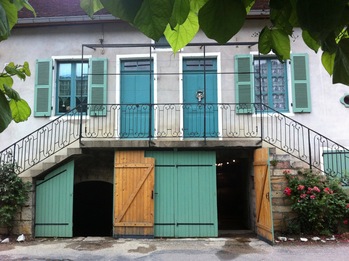 |
| Jean-François Ganevat is looking back to move forward. Like many of the world’s best vignerons, he has re-discovered techniques and grape varieties from the past to make cutting edge wines. After training in Beaune and 9 years as Maître de Chai at Jean-Marc Morey in Chassagne-Montrachet, "Fanfan", as he is known, returned to make wines at his family domaine in 1998, the 14th generation of his family to do so since 1650. His objective was to make wines in Jura with the same philosophy as the best wines of Burgundy. He and his sidekick, a Weimaraner named Schiste, can be found in the sleepy hamlet of La Combe, below the main village of Rotalier. He owns 13 hectares of vines and was fortunate that his father had preserved the ancient, yet outlawed, Jura varieties including Petit Béclan, Gros Béclan, Gueuche (white and red), Seyve-Villard, Corbeau, Portugais Bleu, Enfariné, Argant, Poulsard Blanc. Ganevat finds these varieties interesting because they are easily drinkable with a low alcohol content. They are all inter-planted, like in other ancient vineyard sites across France. As they are not allowed in AOC Côtes du Jura, they go to the Vin de France cuvées.
Jean-François also buys fruit from a total of 10 trusted growers, all of them friends, including two ex-employees who worked for him for many years. He visits them, participates to the harvest, and they all share his philosophy and farming practices. Jean-François likes to keep things interesting and crafts an astonishing number of cuvées, 103 total, that his sister Anne helps him keeping track of. The quality is extremely high across the board: all cuvées are unique, yet they all reveal Jean-François obsessive attention to details and his talent. His wines are generous and powerfully expressive, at once accessible and profound. The total production is around 65,000 to 70,000 bottles, with 70% estate cuvées.
Farming/vinification practices: in 1999, Ganevat converted his property to biodynamic viticulture. In 2006 he completely eliminated the use of sulfur. His crew destems the bunches by hand with a reed tool then the vinification and elevage takes place in a variety of containers: demi-muids (600 liter casks), larger tronconic casks, and since 2014, unlined clay amphoras from Italy. Jean-François very much likes the freshness, salinity and purity they bring to the wines. There is no new oak in his cellar - the older oak, the better. He only uses indigenous yeasts for the fermentation, which lasts a few weeks - he ferments his wines in large volume containers, as the bigger the volume, the slower the fermentation, the best it is for the wine. The wines are then left for a month plus before racking. The whites get a minimum of 2 years of elevage - they come from great terroirs and need time, the reds one year. |
| Crémant du Jura |
This pure Chardonnay Crémant is from grapes picked early in the harvest; the wine is made in demi-muids and rests sur lattes for a minimum of 24 months; bottled with zero dosage. The current release is from the 2010 vintage.
|
(80mmx65mm)_small.jpg) |
| Côtes du Jura - "Cuvée de l'Enfant Terrible" |
100% Poulsard.
From vines planted in 1959 and grown on white and gray marl. Tiny yields, as low as 10 hl/ha. Less than 200 cases produced.
|
(80mmx65mm)_small.jpg) |
| Côtes du Jura - "Plein Sud" |
100% Trousseau.
This is Ganevat’s most important red wine, though production was miniscule in 2014. From vines planted in 1949 and in 2000 on gray marl and pebbles.
|
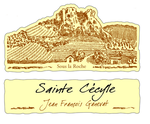 |
| Arbois - "Sainte Cecyle" |
Pinot Noir/Trousseau.
Trousseau 60% and Pinot Noir 40% from similar soils as the Le Clos Pinot Noir; 30 year old vines; raised in Burgundy barrels for 18 months, bottled unfined and unfiltered.
|
(80 mmx65mm)_small.jpg) |
| Côtes du Jura - "Cuvée Julien" |
100% Pinot Noir.
Named after Ganevat's grandfather, this cuvée is from vines planted in 1977 on clay and limestone soil, blended with a bit of Pinot from the Grusse en Billat site as well.
|
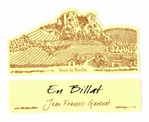 |
| Côtes du Jura - "En Billat" |
100% Pinot Noir.
This particular parcel was planted by Ganevat at a high altitude on schist soils. The very low-yield grapes are destemmed by hand (a very tedious process) and allowed to macerate for a long time. The wine is well-structured with fine tannins.
|
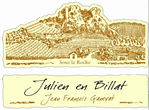 |
| Côtes du Jura - "Julien en Billat" |
100% Pinot Noir.
The Julien and Grusse en Billat were combined because of tiny yields. The 2014 Pinot Noir shows incredible varietal purity and long complex flavors
|
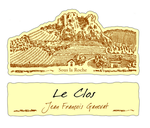 |
| Arbois - "Le Clos" |
100% Pinot noir.
A 1 hectare vineyard consisting of the typical soils of Arbois, gravel and terre d’éboulis (mountain scree), western exposure; raised in Burgundy barrels for 18 months, bottled unfined and unfiltered.
|
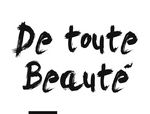 |
| De toute beauté |
Vin de France. 70% Gamay grapes (from Fleurie and Morgon, some grapes come from Château de Grand Pré) blended with old indigenous varieties from Ganevat's vineyards in the Jura: Petit Béclan, Gros Béclan, Geusche, Argant, Peurion, Portugais Bleu, Isabelle, Enfariné... The vines are 50 year old, 14 year old for the francs de pied. The 2014 also has some Pinot Noir, from Alsace (Riquewihr) and the Jura.
5 week vinification (carbonic maceration à l’ancienne) in tronconic cuves. Indigenous yeasts, no fining, no filtration, no added sulfite. Dark and spicy, brambly fruit, brooding wine with long finish.
|
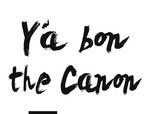 |
| Y'a bon the canon |
Vin de France. Gamay grapes (from Château de Grand Pré in the Beaujolais) blended with old indigenous varieties from Ganevat's vineyards in the Jura: Petit Béclan, Gros Béclan, Geusche, Argant, Peurion, Portugais Bleu, Isabelle, Enfariné... The vines are 30 to 40 years.
Fermentation with indigenous yeasts, no added sulfite. Bright red strawberry and black raspberry fruit, tart and crunchy, with smoky/mineral undertones and a bit of fresh tobacco.
|
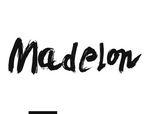 |
| Madelon |
Vin de France. 80% Gamay grapes (from Morgon and Brouilly, Château de Grand Pré), 20% Enfariné from Ganevat's vineyards in the Jura. The vines are 40 year old, 14 year old for the Enfariné francs de pied. Bright, effusive aromas and flavors. Deeper than the Y’a Bon the Canon.
|
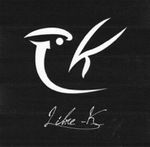 |
| Libre-K |
Vin de France. Gamay from Morgon blended with old indigenous varieties from Ganevat's vineyards in the Jura. Naturally vinified like his other reds: indigenous yeasts, no added sulfites, no fining or filtration. Elevage for 1 year in foudres.
|
(50mmx50mm)_small.jpg) |
| "J'en Veux" |
Vin de France. A blend of 18 ancient red and white non-AOC-approved indigenous varieties, such as Petit Beclan, Beclan, Gueuche, Enfariné, Corbeau, Portugais Bleu, Gouais, Argant, Seyve-Villard. All the vines are franc de pied. Delightful earth and fruit notes, all varieties co-fermented. Each grape is cut off the stem by hand with a small stem attached to keep the berries intact. Just 80 cases produced. First made in 2004.
|
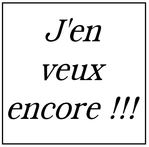 |
| J'en Veux Encore |
Vin de France. Some of Ganevat’s oldest vines (80 years plus) make up this Beaujolais Gamay–Jurassic variety blend. 5 week vinification (carbonic maceration à l’ancienne) in tronconic cuves. No sulfur is added, no fining or filtration, indigenous yeasts. 10 month elevage.
|
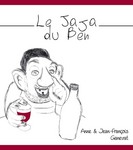 |
| Le Jaja du Ben |
Vin de France. Old vines Gamay blended with ancient Jurassic varieties from granite soils. Vinified in tronconic cuves, carbonic maceration à l’ancienne for 3 weeks, indigenous yeasts vinified naturally without filtering or fining nor any addition of sulfur, elevage for 10 months.
|
(8 0mmx65mm)_small.jpg) |
| Côtes du Jura - "Cuvée Florine" |
100% Chardonnay.
Named after his daughter, this cuvée is made from the “youngest” vines on the estate (planted in 1986 on limestone soil). Impressive, with deep fruits flavors, very expressive, fresh and rich with great acidity.
|
_small.jpg) |
| Côtes du Jura - "Grusse en Billat" |
100% Chardonnay.
From 1.8ha of vines planted in 1960 on schist and marl. A wine with incredible power and energy, the most mineral and direct of Ganevat’s Chardonnays.
|
_small.jpg) |
| Côtes du Jura - “Les Chalasses Vieilles Vignes” |
100% Chardonnay.
From vines planted in 1902 on gray marl. Les Chalasses is a specific vineyard site from which this old-vines cuvee derives. Yields are a miniscule 15HL/HA. This is Ganevat's most powerful and longest aged white, and the last to be bottled. Ganevat first made this cuvée in 1999.
|
(80mmx65mm)_small.jpg) |
| Côtes du Jura - “Les Grands Teppes Vieilles Vignes” |
100% Chardonnay.
From vines planted in 1919 on red marl and gravel. The Grand Teppes VV is a close second to the Chalasses VV, tending to be bigger, richer and more muscular than its sibling. Bettane and Dessauve selected this as one of their top wines of the year. The elevage is in 600 liter casks.
|
(72mmx90mm)_small.jpg) |
| Côtes du Jura - “Cuvée Marguerite” |
100% Chardonnay “Melon Queue Rouge”.
Named after Ganevat's grandmother, this cuvée comes from vines planted in 1902 on gray marl. As he can make so little of this wine, Ganevat only bottles it in magnums. This is made from a ancient variety of low-yielding Chardonnay known as “Melon Queue Rouge” or "red-tailed" Chardonnay because the stems are red. This is the lushest of his Ganevat's Chardonnays, with exotic notes and mind-bending intensity.
|
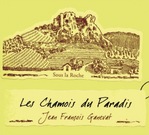 |
| Côtes du Jura - "Les Chamois du Paradis" |
100% Chardonnay.
A brilliant old-vines Chardonnay grown in clay/limestone soils. Very low yields. The wine is raised in demi-muids without any intervention and without and addition of SO2, for around 2 years. During this time the casks are topped off (ouillé) to avoid oxidation. Bottled without fining or filtering. 12.5% alcohol.
|
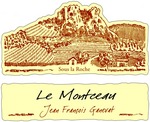 |
| Côtes du Jura - "Le Montceau" |
100% Chardonnay.
The soil is Jurassic limestone known as marne du lias (also found in Gevrey). The grapes are whole-cluster pressed then moved to foudres and left untouched for 12 months without any addition of sulphur. 12% alcohol.
|
 |
| Côtes du Jura - "Cuvée du Pépé" |
100% Chardonnay.
Very old vines (70 years plus) on marne soils. This single, estate vineyard has a south-east exposure. The cuvée is made sous voile, which is rare for Chardonnay. Aged 8 years in barriques.
|
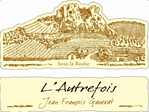 |
| Côtes du Jura - "L'autrefois" |
100% Chardonnay.
Vines planted in 1961 on Marnes du Lias. Vinified sous voile for 48 mois, in 7 to 10 year barriques.
|
 |
| Arbois - "Le Clos" |
100% Chardonnay.
From vines 20 to 45 years old in gravel soils, southerly exposure; whole-cluster fermentation; raised on the lees for 30 months in demi-muids; bottled unfined and unfiltered.
|
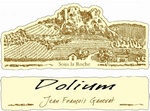 |
| Arbois - "Dolium" |
100% Chardonnay from 60 year old vines - lias marl soil.
Vinified as a red wine. Aged in 10 hl amphoras (from Italy) for 30 months. Slightly oxidative. Indigenous yeasts, no sulfur added, unfined and unfiltered. 2012 was the first vintage, created as an experiment.
|
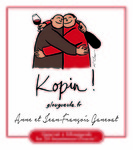 |
| Kopin |
Vin de France. A blend of Chardonnays from the Jura and Burgundy (Mâconnais) with an addition of Riesling (30%) from a biodynamic vineyard in Alsace. All the grapes are vinified together. Elevage 1 year in barriques (1 to 10 year old).
|
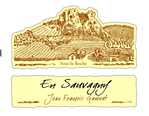 |
| Arbois - "En Sauvagny" |
Chardonnay/Savagnin.
Equal parts Savagnin and Chardonnay, 40 year old vines, southern and western exposure; whole cluster fermentation; raised on the lees for 30 months in demi-muids; bottled unfined and unfiltered.
|
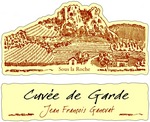 |
| Côtes du Jura - “Cuvée de Garde” Sous-Voile |
50% Chardonnay, 50% Savagnin.
From vines planted in 1973 and 1977 on blue marl and white marl. Vinified “sous voile” for 4 years in the traditional Jura manner. A true Vin Jaune needs to be “sous voile” for 6 years and 3 months, so here Ganevat goes his own way making a solid expression of this style. 13.5% alcohol.
|
_small.jpg) |
| Côtes du Jura - "Les Chalasses Marnes Bleues" - Ouillé |
100% Savagnin.
From vines planted in 1933 on clay soils which favor Savagnin (in this case the type known as Savagnin Vert). A very impressive wine made in a non-oxidative style (the wine is "ouillé", meaning the foudres or tanks are regularly "topped up" to prevent oxidation), this cuvee combines richness of fruit, minerality and clear varietal identity.
|
_small.jpg) |
| Côtes du Jura - "Les Vignes de mon Père"(ex Mon Père) - Ouillé |
100% Savagnin.
From Savagnin Vert vines, planted in 1930 on the blue marl of the Chalasses site. Aged 8 to 11 years (there are three releases of the wine during the process) in cask and topped up regularly. A very big, deep wine with slight oxidative notes, even though it is ouillé (meaning the foudres or tanks are regularly "topped up" to prevent oxidation).
|
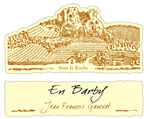 |
| Arbois - "En Barby" |
100% Savagnin.
From a single 0.8 hectare plot of Savagnin facing west and south, clay-limestone soils; destemmed grapes before pressing; raised for 30 months in demi-muids; bottled unfined and unfiltered.
|
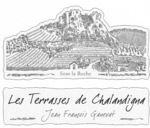 |
| Côtes du Jura - "Les Terrasses de Chalandigna" |
100% Savagnin, sous voile.
Ganevat favors using large vats and humid cellars for his oxidative wines. This traditional approach is directly opposite to the rest of the Jura where small barrels and dry cellars are the norm. He feels that he can obtain much more refined, elegant wines this way. This cuvée is remarkably fragrant with hints of stone fruits, honey and walnut. Aged for at least 4 years. 13% alcohol.
|
| Côtes du Jura - Savagnin Non Ouillé |
100% Savagnin from clay and limestone soil. West and South facing vineyards. Yields: 40 hl/ha. The vines average 35 year old. Aged in large wooden vats, not topped of, for at least 3 years. Bottled unfined and unfiltered.
|
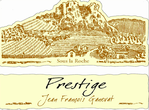 |
| Côtes du Jura - "Prestige" |
100% Savagnin.
Ganevat favors using large vats and humid cellars for his oxidative wines. This traditional approach is directly opposite to the rest of the Jura where small barrels and dry cellars are the norm. He feels that he can obtain much more refined, elegant wines in this way.
|
_small.jpg) |
| Vin Jaune |
100% Savagnin.
An intense, pure and memorable wine.
|
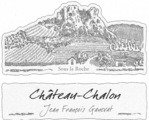 |
| Château Chalon |
100% Savagnin.
The harvest for this wine is late, two weeks after the Chardonnay, in mid-October. After the alcoholic fermentation, the wine is placed in 228 liter barrels for 6 years and 3 months, as is traditional. The barrels are not topped up, allowing for a veil of specific yeasts to form slowly and to give this wine its unique character. 14% alcohol.
|
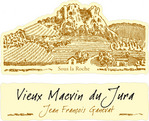 |
| MacVin |
Grape must (Chardonnay and a little Savagnin) is blended with Vieux Marc du Jura. Aged in Burgundy barrels since 2003 and bottled recently. This Macvin is sensational, with explosive aromas of pineapple and pine forest followed by a potent palate filled with an array of dried fruit flavors.
|

